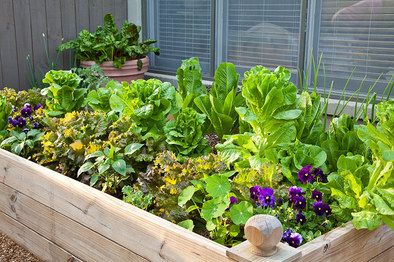 Think you have to live on a farm to grow vegetables? Think again. People in rural, suburban, and even urban areas with small landscapes, have success in growing vegetables in raised garden beds. Some of the best tomatoes I've had are from a friend's very small garden on a main street in Brockton. Raised-bed gardening is a great way to grow vegetables. It does not require much space and can be incorporated into your existing landscape easily. A raised garden bed works well even if your ground soil is undesirable or has poor drainage, and there's less bending over to weed or harvest vegetables. Drainage in a raised bed is superior to that in an in-ground garden bed. The soil in raised beds warms up more quickly in spring so planting can be done earlier. A 12"-deep bed provides ample room for most vegetable roots. Two exceptions are potatoes and corn. Potatoes require a lot of room for their roots and corn can grow so high that harvesting would be difficult. If your raised bed is narrow (maybe 3 - 4 feet maximum), there’s no need to step on the soil to reach all of your veggies. This helps prevent compaction. It's much easier for roots to grow in loose soil. A raised garden bed can be built directly over grass, dirt or even a concrete patio. Don't build a raised bed on a wooden deck: when it’s full of soil and water, the weight could cause structural damage to the deck. If the raised bed sits directly on soil, line the planting bed with chicken wire when installing the bed to keep burrowing animals at bay. The bed may be made of wood, stone, brick, metal, or any other material. If you want to go with wood, redwood or cedar are attractive and resist rot. Choose a spot in your existing landscape that you can reach with your hose and gets at least six hours of sun a day. Here’s a great how-to for building and installing a raised bed vegetable garden yourself. Good luck!
0 Comments
 Spring is one of the best times to plant grass seed. In winter, it’s too cold for grass seed to germinate. In summer, it can be challenging to keep grass seed moist on extremely hot days. In spring, temperatures are moderate and there’s typically good amounts of rainfall, making watering less of an issue. If the soil and temperature conditions are right, planting grass seed is not a challenging job and can be done by anyone. The following are the few steps to take to successfully plant grass seed. 1. Prepare the soil If there is any existing grass, mow it as low as possible to allow maximum sun and moisture to the areas where you’ll sow grass seed. Loosen the top 2 inches of soil and remove any debris (including sticks, stones, dead grass). Level out any areas where water may puddle. Avoid using weed killers prior to planting grass seed. (Wait until grass has effectively grown and gone through a few mowings). 2. Plant grass seed Invest in high quality grass seed. You want to get grass seed that has been bred for insect and disease resistance, superior color and drought tolerance. Great grass seed will help in growing a great lawn. Use a handheld or push lawn seeder to evenly distribute grass seed in large areas. In smaller areas, you can spread grass by hand evenly. Apply a starter fertilizer when you sow your seeds (and then add more fertilizer three to four weeks later). 3. Cover grass seeds Gently go over the grass seed bed with a rake turned upside down. With the spikes of the rake facing up, drag the rake across the seed bed so that just ¼” of soil covers most of your grass seed. This topsoil will help hold seeds in place and provide moisture. 4. Water regularly The grass seed bed should be kept moist at all times to help the seeds germinate. Water at least daily to ensure moisture. Most likely you’ll want to water 2 – 3 times daily, but water lightly – do not saturate. Once you see new grass sprout, continue to water regularly to ensure the roots get moisture. Depending on the type of grass seed you use, you should start to see your new lawn within 2 - 4 weeks. (And also depending on Mother Nature!) Avoid mowing new grass until it has reached 3 inches, and be sure to use a sharp blade on new grass. |
Archives
February 2024
AuthorRodrigo Dos Anjos Categories
All
|
Gardenin' Angels, Landscape Management & Construction
A preferred landscaper, serving Southeastern Massachusetts
11 Renker Drive, Easton, MA 02375
774-284-1171
[email protected]
Privacy Policy • Terms of Use

 RSS Feed
RSS Feed